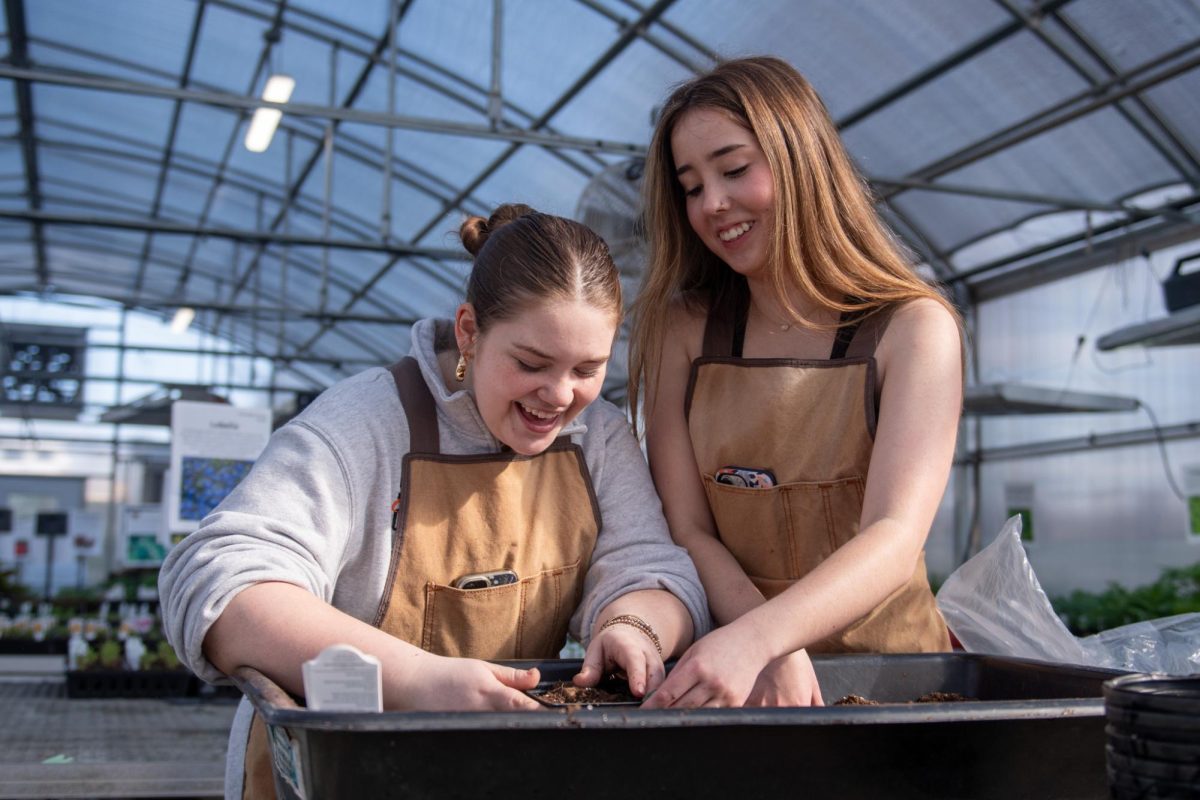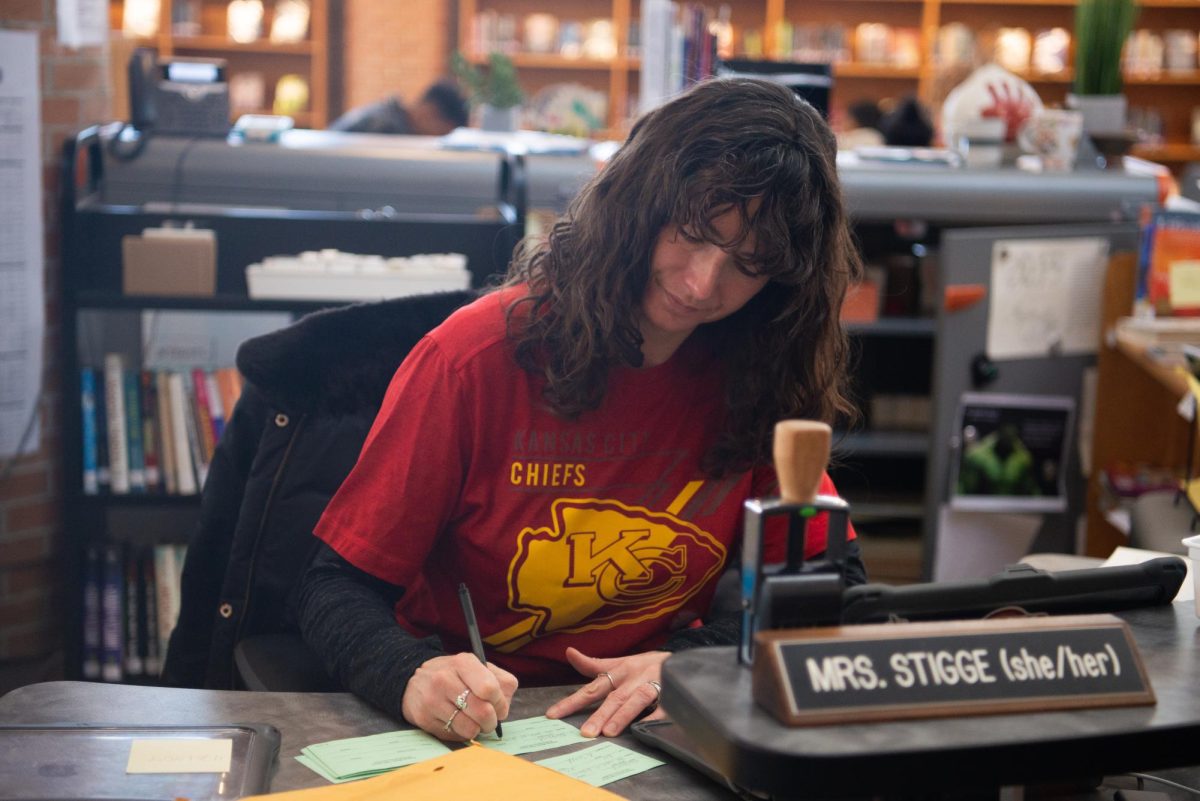After three years of holding art shows for only art department teachers, the NW art gallery was open to any faculty members who wanted to showcase their work.
Teacher artwork lined the wall of the NW art gallery, each lit by a spotlight and accompanied by a statement from the artist. The gallery featured paintings, photography, pottery, cross stitching, sewing and even a hologram made by faculty members. Each work told a story about the teacher. For three weeks, Northwest celebrated teachers instead of students.
“I think there’s a novelty with the teachers because the kids don’t expect their ELL para to be great with chalk pastels,” Terryberry said. “It’s a nice little look into their personal life.”
Art teachers Chandra Beadleston, David Hunt, Melinda Heaton and Melissa Terryberry organized the gallery. It was open from 7:30 a.m. to 3:30 p.m. in the gallery in the mall from Aug. 22 to Sept. 4.
“I think we have very talented teachers on faculty and some people that are really good artists in their own right,” orchestra teacher Jeffrey Bishop said, “besides our art faculty. Obviously, they’re all amazing pro-level artists.”
Although the art department sent out requests to the faculty at the end of last school year, teachers hesitated to sign up.
“They felt that their stuff wasn’t artistic or wasn’t good enough, Terryberry said. “If they had a photo of their kid or a quilt or a needle-working thing, they weren’t sure it was fine art.”
Thimes doubted he would participate until Hunt asked him to make a hologram for the art show. A hologram is a two-dimensional representation that looks three-dimensional with the use of lasers.
“I thought it was cool because it was one of those, ‘What is art?’ and, ‘Do we have to conform to everybody’s notion of what art is?’” Bishop said.
Thimes first saw the idea at a science convention and since then he has been making a hologram every year with his Physics 2 class.
“It’s probably the most positive response that I get from my Physics 2 class,” Thimes said.
Spanish teacher Kathy Tarbutton’s contribution to the show was a sleeveless, colorblock dress that she made this summer.
“I thought ‘Why not celebrate teachers too?’” Tarbutton said.
Bishop’s students weren’t aware that their music teacher also had talent as a visual artist. He took pictures of his backyard and made a landscape painting. It was his first finished painting.
“Kids were just really surprised because he’s talented in music, but to see a nice painting is something that’s different and new,” Terryberry said.
Art department teachers plan to make the faculty art show an annual event. Thimes is already coming up with ideas for next year.
“I would like to see every faculty member participate,” Bishop said, “not just the woodworking teacher or the art teacher or the music teacher, but actually get everybody to do something artistic.”
Teachers that participated could come up with a title and artist’s statement to go with their pieces. Here are the teachers’ names, their job title, artwork title, and their artist’s statement:
Brad Qualls – SMNW Special Education Teacher – “Boy of Summer” – “Taken with iPhone 4 as I coached my son in a baseball this summer. This picture reminds me of how small he still is and even with the potential he has, he is still only a child playing a game.”
Bob Stewart – Physics Teacher – “Capitol Center Building (detail) Columbia, SC” – “This photograph calls attention to details that often get overlooked. The exploration of the overlooked helps us engage more deeply with where we are in space and time. A focus on details keeps us in the present; it stops us from fretting about the future or regretting the past. My goal is to take photographs that draw viewers into the now, acting as a visual meditation.”
Cathie Morrison – educator – “Feast of Stephen”- “A quiet wintery day on a farm when the only sound is the crunch of snow as you head home.”
Chandra Beadleston – art teacher- “Pot #2/2” – “This pot was created in multiple pieces. I used the spray booth to spray on the potters wheel. 5 different glazes on the surface in layers.”
David Hunt – Art Teacher – “The Old Troost Avenue Bridge” – “This painting was made en plein aire, or directly from observation in the open landscape, not in the studio. Many beautiful and historic building and bridges in Kansas City have been (and are being) destroyed, including this historic bridge where Troost Avenue crossed over Brush Creek. I was able to study its fine arches and lovely proportions, which are only memories now. Fortunately I was able to ‘salvage’ the bridge with this picture and to warn us of the glorious architectural past that is being forgotten in our rush to modernize America.”
Jeffrey S. Bishop – Orchestra Teacher, D.C. Fine Arts & Phys. Ed. – “Landscape Study #1” – This is my first 2D painting, as most of my painting is done on gaming miniatures for a game called Warhammer. I’ve always been an artist, mostly musical, but I love to draw, paint, and create. I like to call this “Prairie Impressionist Style,” because, like real Impressionism, the farther you stand away from it the better it looks! The meaning of this work? Create. Just create and be passionate about whatever it is that you do. Whether its science, math, writing, playing and instrument, whatever. Just create to the best of your ability and have fun with it.”
Joe Thimes – Physics Teacher – “Illusion or Real?” “The holograms on display are direct beam reflection holograms. With a reflection hologram, the image is stored in a thick emulsion and can be viewed in white light. The emulsion is on one side of a glass plate. A laser is used to produce two beams, and object beam that reflects off the object being used to form the hologram, and a reference beam that comes directly from the laser. The two beams make an interference pattern on the emulsion. When the hologram is viewed in white light, the interference pattern reflects an image of the object in three dimensions.”
Kathy Tarbutton – Spanish Teacher/D.C. for World Languages – “A lined, Sleeveless Dress” – “I love to sew, especially during the summer. I have made this dress several times, and decided to alter the pattern to give it a colorblock feel.”
Michael Pisani – science teacher
Melissa Terryberry – art teacher – “Suture” – “The title is Suture after the ridges of the skull. This piece is a monoprint, this means that there is only one. I applied the paint to plate or the piece that was worked to from depth Then I pressed it to a wet piece of paper in a mill. (You can see the indentation along the edges.) This transferred the paint to the paper in a unique way. I like the texture in my art, this process let me add more texture in brush strokes and in the transfer process, note the bottom right corner is speckled.”
Mindy Heaton – art teacher – “Chillin’ in Key West – w/ Family, Christmas ‘12” – “I love taking pitcures when I travel with my family. I enjoy new adventures and sharing every experience with the people I care most about. America is a fantastic place to see. Every state and city is different – the people, the landscapes, the weather, the architecture – all very fascinating. I’ve been creating m panoramas for about 10 years now. They are produced in color, B&W, and a combination of the two. I try to capture the essence of space using a 2D medium in a 3D presentation to achieve a feeling of depth for the viewer. Hope you enjoy a glimpse of my world, as Key West is just one of many.”
Rebecca Williams – SPED CT English 9 – “Messing Around with COPICS” – Blending markers… matching pattern papers, stamps and usings COPICS to blend in the colors within the stamp to create fun cards.” What are COPICS.
Rhonda Talbott – Production Center – “Whale of a Time” – “Iris folding is a paper folding technique which originated in Holland in the 1700s. Dutch crafters would cut the patterned envelopes of the time, from businesses in Holland, as well as other European countries, into small and then folded them. A pattern was created to placed the folded paper on and the design gives the illusion of being a spiral focused around a central point. The end result resembled the irs of an eye, which is what gives the technique the name ‘Iris folding.’ From these folded strip of paper, original works of art were created. I have found it to be fun to make unique ‘one of a kind’ cards using the Iris folding technique.”
Stacie Anderson – Special Education Teacher – “Girl with Roses” – “Counted cross stitch.”
Susan Massy – Yearbook & NW Passage sponsor – “Memorial” – “These monarchs were among the thousands that crowded onto the 37 acres of prairie owned by my parents beginning on October 2, 2006, the morning my father died. They continued to gather until the day of his memorial service a week later and the prairie appeared alive with their movement. Their numbers dwindled over the next week until all had moved on. They have never returned. ‘Death is simply a shedding of the physical body like the butterfly shedding its cocoon. When we have passed the tests we are sent to Earth to learn, we are allowed to shed our bodies, which imprison our souls. – Elisabeth Kubler-Ross’”




